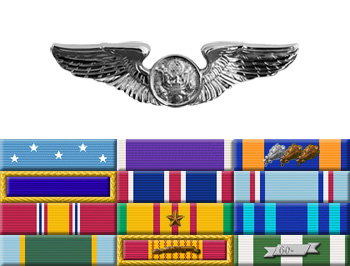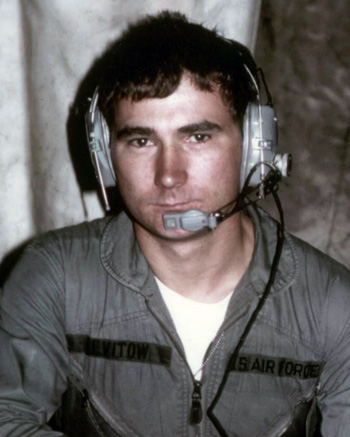John Levitow was born on November 1, 1945, in Hartford, Connecticut. He enlisted in the U.S. Air Force on June 6, 1966, and was trained as an Electric Power Line Specialist, serving with the 438th Civil Engineering Squadron at McGuire AFB, New Jersey, from July 1966 to October 1967. Levitow cross-trained as an aircraft loadmaster and flew as an aircrew member on C-130 Hercules transports with the 45th Military Airlift Squadron at McGuire AFB, from October 1967 to July 1968, when he was sent to Southeast Asia to serve as a loadmaster on AC-47 Spooky gunships. He served with the 3rd Special Operations Squadron flying out of Nha Trang AB in the Republic of Vietnam from October 1968 until he was badly injured during a mission on February 24, 1969, for which he would later be awarded the Medal of Honor. After hospitalization for his injuries, Levitow returned to Vietnam in May 1969 and flew another 20 combat missions before being transferred to the 14th Military Airlift Wing at Norton AFB, California, in August 1969. He served as a C-141 Starlifter loadmaster at Norton AFB until he received an honorable discharge on April 3, 1970. Sgt Levitow was awarded the Medal of Honor by President Richard Nixon at the White House on May 14, 1970. John Levitow died on November 8, 2000, and was buried at Arlington National Cemetery.
His Medal of Honor Citation reads:
For conspicuous gallantry and intrepidity in action at the risk of his life above and beyond the call of duty. Sgt. Levitow (then A1C.), U.S. Air Force, distinguished himself by exceptional heroism while assigned as a loadmaster aboard an AC-47 aircraft flying a night mission in support of Long Binh Army post. Sgt. Levitow's aircraft was struck by a hostile mortar round. The resulting explosion ripped a hole 2 feet (0.61 m) in diameter through the wing and fragments made over 3,500 holes in the fuselage. All occupants of the cargo compartment were wounded and helplessly slammed against the floor and fuselage. The explosion tore an activated flare from the grasp of a crew member who had been launching flares to provide illumination for Army ground troops engaged in combat. Sgt. Levitow, though stunned by the concussion of the blast and suffering from over 40 fragment wounds in the back and legs, staggered to his feet and turned to assist the man nearest to him who had been knocked down and was bleeding heavily. As he was moving his wounded comrade forward and away from the opened cargo compartment door, he saw the smoking flare ahead of him in the aisle. Realizing the danger involved and completely disregarding his own wounds, Sgt. Levitow started toward the burning flare. The aircraft was partially out of control and the flare was rolling wildly from side to side. Sgt. Levitow struggled forward despite the loss of blood from his many wounds and the partial loss of feeling in his right leg. Unable to grasp the rolling flare with his hands, he threw himself bodily upon the burning flare. Hugging the deadly device to his body, he dragged himself back to the rear of the aircraft and hurled the flare through the open cargo door. At that instant the flare separated and ignited in the air, but clear of the aircraft. Sgt. Levitow, by his selfless and heroic actions, saved the aircraft and its entire crew from certain death and destruction. Sgt. Levitow's gallantry, his profound concern for his fellowmen, at the risk of his life above and beyond the call of duty are in keeping with the highest traditions of the U.S. Air Force and reflect great credit upon himself and the Armed Forces of his country.
|



